If there is one new trend taking hold of pistol manufacturers, it is making optics-ready pistols. These handguns come out of the factory with the ability to mount a reflex-style red dot sight. The newest is the Glock G17 Gen4 MOS, which debuted in 2016. Kahr, SIG, and the Canik from Century Arms may also see optics-ready models in 2016. Custom gun makers have been crafting pistols with reflex sights for years, and back in 2012, both S&W and FN launched optics-ready pistols. Just like Picatinny rails have emerged as a widespread feature and laser pointers are being offered on many handgun variants, the optic mount is the next evolution of the handgun.
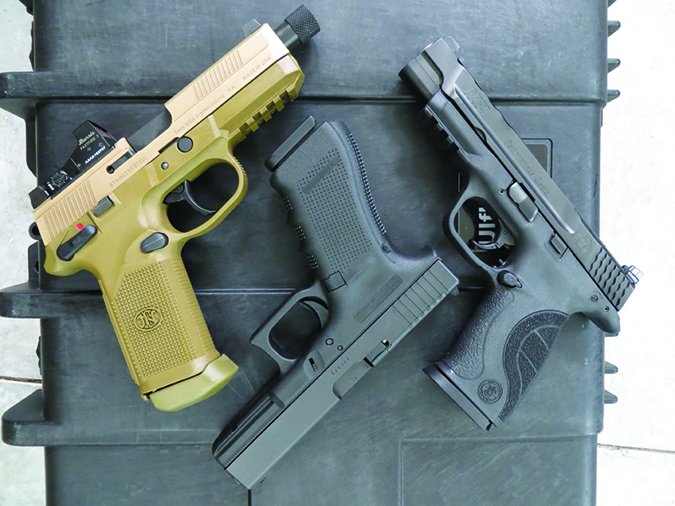
We have seen this same scenario play out with AR rifles, where optics were once an anomaly and they are now the norm. Why? Ease of aiming and faster target acquisition. What, perhaps, has slowed the trend is cost. Reflex sights can add anywhere from $240 to $600 extra, depending on the sight. There may also be a need to purchase a new holster to accommodate the optic on the handgun and taller iron sights. This seems a little odd to us because many shooters might consider the cost to be excessive on a handgun, but we don’t think twice about mounting a high-quality optic on a rifle.
There is no doubt that in the same situations, red-dot reflex sights allow users to aim faster and easier compared to iron sights. Also, reflex sights allow users to aim with both eyes open, peering through a small glass lens that the sight uses to project a reticle onto it via a light-emitting diode. The sight provides an unlimited field of view since there is no magnification and no tube, so tunnel vision is less of an issue when aiming. Also, there is also no need to align three planes — target, front sight, and rear sight — as with iron sights. However, during testing, we found that taller iron sights that co-witnessed with the red dot were preferred because they can help find the dot. Also, BUIS are there in case the optic fails or the battery dies when we need it most. A proper maintenance schedule can alleviate this concern.
To see how various red dots could be mounted and used on factory optics-ready pistols, we acquired a Glock G17 Gen4 MOS, an S&W M&P9 Performance Center Ported model, and an FN America FNX-45 Tactical FDE. The Glock and S&W were 9mm striker-fired pistols that are well known to us. We have reviewed numerous Glock G17 models over previous model generations, but this is first G17 Gen4 MOS that our testers have evaluated. The same is true with the S&W M&P9. We have tested other variants of the M&P9, but this is a first for the S&W M&P9 Performance Center Ported model. The 45-caliber FNX-45 Tactical is also new to our testers. What we were looking for with these optics-ready pistols was ease of installation, accuracy, ease of use, and durability.
For reflex sights we used an older Leupold DeltaPoint ($499), which has been discontinued and replaced with the DeltaPoint Pro and a new Burris FastFire III ($239). We tested these two reflex sights in the July 2014 issue and gave them an A+ and an A-, respectively. We also tried a new Meopta MeoRed ($517) reflex red-dot sight. The MeoRed was specifically designed for use on handguns with cutout slides, as well as AR platforms and shotguns. Made from aircraft-grade aluminum alloy, the sight is waterproof and shockproof and comes with an integrated MIL-STD 1913 mount and an adapter plate mount, but we used the mount with the pistol. It features a 3-minute-of-angle red-dot reticle with adjustable brightness levels. To turn the unit off, press the button and hold. There is also an auto-off function that turns the unit off after three hours of continuous operation if the function button has not been touched. The MeoRed is powered by one CR 2032 battery for up to 300 hours of run time and features a low-battery indicator dot that signals when the battery is running low. The battery compartment is on the right side of the sight and can be accessed without taking the sight off the gun, as it is secured with two screws to ensure constant battery contact during recoil. We liked the auto turn off feature and the ability to change the battery without removing the sight from the adapter plate.

The FN, Glock, and S&W all came from the factory with a cover plate attached to the top of the slide just forward of the rear sight. A hex wrench was used to remove the plate and replace it with a mounting plate the corresponded to a specific model and brand of reflex sight. All three manufacturers include the tools to mount the sights, and as we found out, some provided more mounting options than others. All the hardware types mount the sight slightly differently, as we will explain.
Mounting the sight allows the user to also keep the iron sights mounted on the slide, and the FN and S&W featured taller iron sights that co-witnessed with the red dot. The Glock’s sights were standard size and could not be used when a red dot was attached, so if the shooter wanted to co-witness (shoot to the same point of impact) iron sights with the red dot, he would have to install taller Glock sights like those used with a suppressor, which would appear in the reflex sight window. Mounting the optics was straight forward. We installed the sights in under five minutes using the tools the manufacturers provided. We also aligned the red dot with the taller S&W and FN sights to make zeroing the red dot quicker.
Once the sights were installed and zeroed, we dropped each unloaded pistol from waist height onto the ground to see if the zero would be knocked off, and found that did not happen. With the sight attached, we also used it for purposes for which it was not intended, like using the sight as a makeshift cocking lever. That’s not something we would normally do, but we may need to do it in a pinch. In all cases, the mount held and the sight did not lose zero. Across the board, we found the sight/pistol combination very durable and rugged. Here are the rest of the details about how each firearm performed in our rigorous shooting trials:
Smith & Wesson M&P9L Performance Center Ported 10098 9mm Luger, $812
GUN TESTS GRADE: A
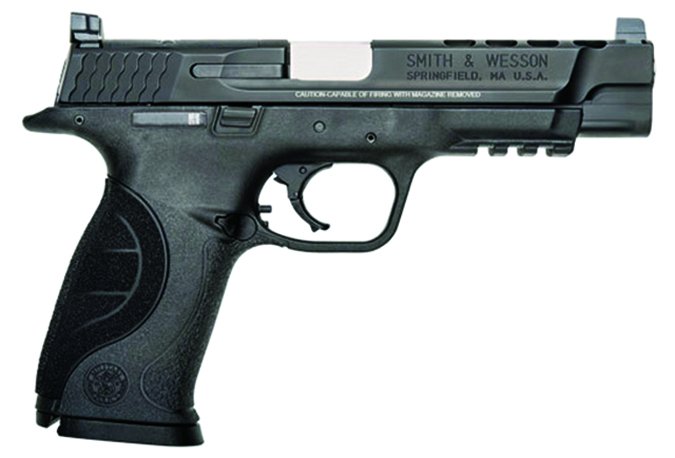
This Performance Center M&P9 provided six reflex-sight mounting options, had tall sights, and employed enhanced features that we thought made it a good value.
| ACTION | Semi-auto, double action striker fired |
| OVERALL LENGTH | 8.5 in. |
| OVERALL HEIGHT | 5.3 in. |
| MAX WIDTH | 1.3 in. |
| WEIGHT UNLOADED | 24.1 oz. |
| WEIGHT LOADED | 30.9 oz. |
| BARREL | 5 in. long, 8 ports; stainless steel |
| CAPACITY | 17+1 |
| SLIDE | Black, stainless steel, 8 ports; optics cut top |
| FRAME | Black polymer; 3-slot picatinny rail |
| FRAME FRONT STRAP HEIGHT | 2.3 in. |
| FRAME BACK STRAP HEIGHT | 3.4 in. |
| GRIPS | Textured polymer; 3 modular backstraps |
| GRIP THICKNESS (max) | 1.2 in., 1.25 in., 1.3 in. |
| FRONT SIGHT | 5.5 in., 5.7 in., 6 in. |
| REAR SIGHT | White dot dovetail |
| OPTICS MOUNTS | Trijicon RMR, Leupold DeltaPoint, Jpoint, Docter, C-MOre STS, Insight MRDS |
| TRIGGER PULL WEIGHT | 4.5 lbs.; adjustable trigger stop; performance center sear |
| TRIGGER SPAN | 2.6/2.8 in. |
| MAGAZINES | 1; steel, double stack |
| SAFETY | Decocking/Safety lever |
| WARRANTY | Lifetime |
| MADE IN | USA |
| WEBSITE | Smith-Wesson.com |
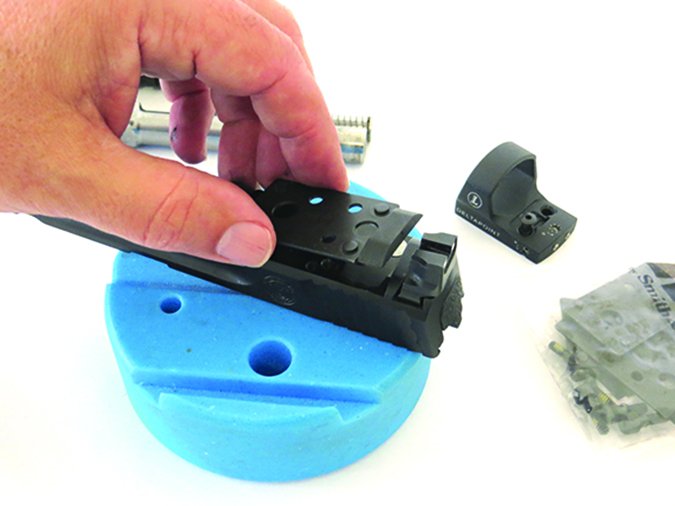
The list price is shown above. We found this pistol for as low as $656 cash at BudsGunShop.com. Other taxes, handling, and shipping charges may apply, which we don’t account for in our reporting of retail prices. As always, we report retail prices to give readers some insight into what firearms might actually be selling for in the market. We do not endorse any retailer, and we have no fiduciary relationship with any retailer.
The Smith & Wesson M&P9 Performance Center Ported pistol was designed to compete out of box in action-shooting competitions. It comes in a hard case with one steel magazine, three grips and a tool to replace them, and S&W’s C.O.R.E. (Competition Optics Ready Equipment) adapter plates, screws, and wrenches for up to six reflex-sight options. We mounted the Leupold DeltaPoint and found the installation straightforward and easy.
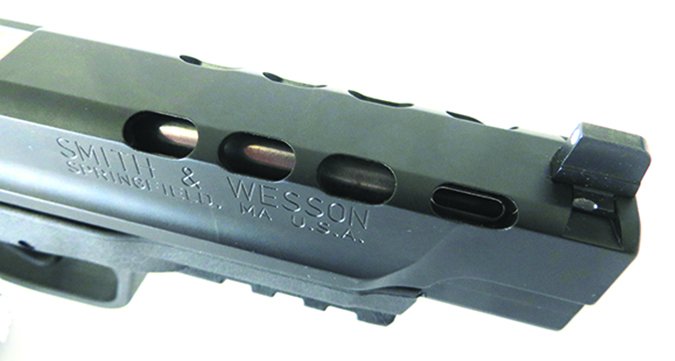
The process: First find the corresponding plate, place it on the slide, then use the two screws to sandwich the plate between the optic and slide. Just determine which adapter plate works with your sight; the Trijicon RMR, Leupold DeltaPoint, C-More STS, Doctor, and Insight MRDS are supported. Also, the M&P9 came with tall three-dot steel sights that co-witnessed with the Leupold and were dovetailed into the slide.
This Performance Center pistol featured a ported barrel with two oblong ports that aligned with the two forwardmost ports in the slide. The slide had eight slots milled into it to reduce weight and vent gases. The stainless-steel barrel also had a viewing port that allowed the shooter to see if a round or case was in the chamber. The recoil spring in the M&P9 was a flat coil spring with a steel one-piece recoil guide rod.
The frame featured three grip inserts that adjusted the trigger span as well as provide a bit of a palm swell. The panels had a toothy texture that nonetheless did not abrade the skin. Most testers liked the palm swell and chose to use the small grip module. The FN and Glock had flat grip sides. The M&P9 stored the grip tool in the butt heel, which we thought was a good idea since it is always handy and will not get lost.
The trigger was enhanced on this model with a Performance Center sear that provided a crisp 4.5-pound trigger press. The trigger also reset faster and was equipped with an overtravel adjustment screw. The grip module needed to be removed to adjust the stop with a supplied hex wrench, which is also stored in the butt of the M&P9. We liked how the trigger broke, with some test members preferring the flat face of this trigger compared the to round trigger face of the Glock.
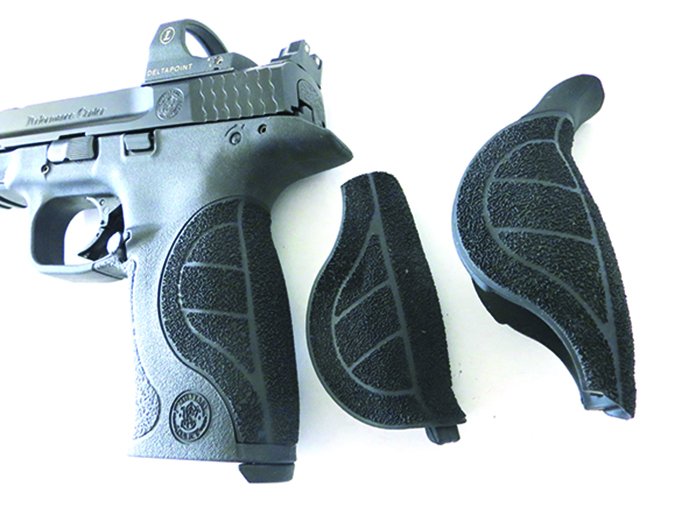
At the range most testers agreed that M&P9’s grip made a favorable first impression. The pistol had nice balance and presented a low bore axis, so the gun sits low in the hand. We ran the M&P9 Performance Center on paper at 25 yards and found we were surgically accurate with it using two ammos. With the Hornady American Gunner shooting 115-grain XTP bullets, we averaged 0.9-inch five-shot groups. The Winchester Train ammo averaged 1.0 inches. We liked this accuracy and attributed the performance to the enhanced Performance Center trigger. In rapid fire, we felt the M&P9 had slightly less muzzle flip than the Glock due to the ported barrels. We also noted that the M&P9 with the ported 5-inch barrel provided more muzzle velocity than the non-ported 4.4-inch barrel of the Glock.
Our Team Said: We liked the Leupold sight on this handgun, and we liked the redundancy of the iron sights being visible through the optic. The Performance Center M&P9 provided six reflex sight mounting options, had tall sights, showed a great trigger, could be adjustable to a variety of hand sizes, and presented other enhanced features. It is a good choice and good value, in our view.
Glock G17 Gen4 MOS PG1750203MOS 9mm Luger, $726
GUN TESTS GRADE: A-
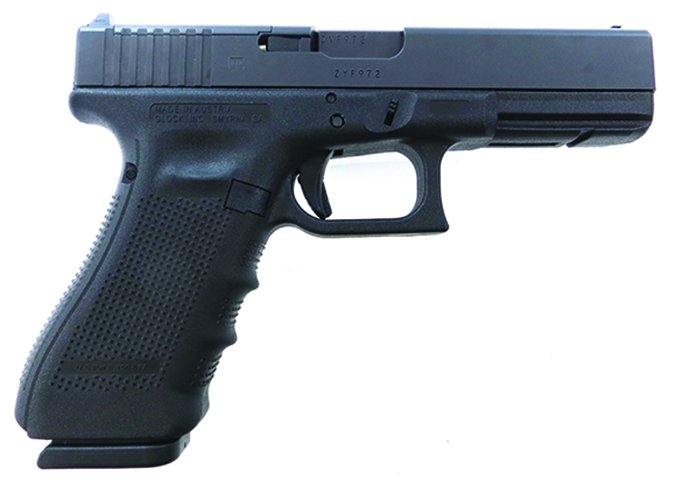
The G17 Gen4 performed well with optics, and they were easy to install with plenty of adapter plates. We would have preferred taller sights like those on the Smith.
| ACTION | Semi-auto; locked breech, striker fired |
| OVERALL LENGTH | 7.9 in. |
| OVERALL HEIGHT | 5.4 in. |
| MAX WIDTH | 1.2 in. |
| WEIGHT UNLOADED | 25.1 oz. |
| WEIGHT LOADED | 32.1 oz. |
| BARREL | 4.5 in., stainless steel; RH hexagonal rifling |
| CAPACITY | 17+1 |
| SLIDE | Black steel; optics cut top |
| FRAME | Black polymer; reversible enlarged magazine catch; 1-slot accessory rail |
| FRAME FRONT STRAP HEIGHT | 2.5 in. |
| FRAME BACK STRAP HEIGHT | 3.5 in. |
| GRIPS | Textured polymer; finger grooves, 4 backstraps |
| GRIP THICKNESS (max) | 1.2 in. |
| GRIP CIRCUMFERENCE (max) | 6 in., 6.2 in., 6.4 in. |
| FRONT SIGHT | Fixed blade w/ white dot |
| REAR SIGHT | Outline |
| OPTICS MOUNTS | Trijicon RMR, Leupold DeltaPoint, Meopta, Docter, C-More, Insight MRDS |
| TRIGGER PULL WEIGHT | 5.5 lbs., safe action |
| TRIGGER SPAN | 2.8 in., 2.9 in., 3 in. |
| MAGAZINES | 3; polymer double stack |
| SAFETY | Trigger, firing pin, drop safeties |
| WARRANTY | Limited 1-year |
| MADE IN | Austria/USA |
| WEBSITE | US.Glock.com |
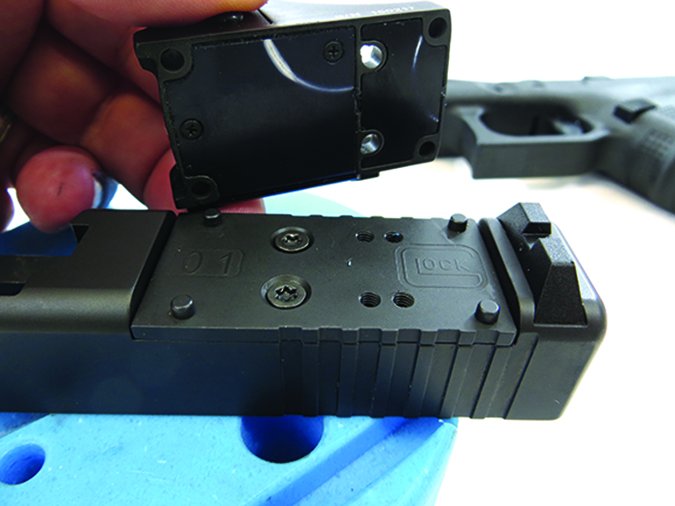
The list price is shown above; several retailers had the model on sale for $599, including Omaha Outdoors. The Glock G17 Gen4 MOS (Modular Optic System) variant comes in a polymer carrying case with three magazines, four grip adapters — two with and two with out a beavertail — with a tool, and a mounting-plate kit consisting of four adapter plates, screws, wrench, and instructions. These adapter plates allow mounting of a reflex red-dot sight from Trijicon (RMR), Leupold (DeltaPoint), Meopta, C-More, Docter, EOTech, and Insight. We counted seven different sight options, which was more than the other pistols.
The G17 Gen4 MOS has a small cover plate just forward of the rear sight, which we removed. A razor was needed to initially separate the plate and the slide. We used the plate that corresponded to the Meopta and screwed that to the slide, then screwed the Meopta to the plate adapter. The standard sights did not co-witness with the optic. A set of tall aftermarket sights would cost an additional $110 to $150 from Glockstore.com, which would increase the total cost to $836-$876 and bring the money for the three pistols tested into the same range.
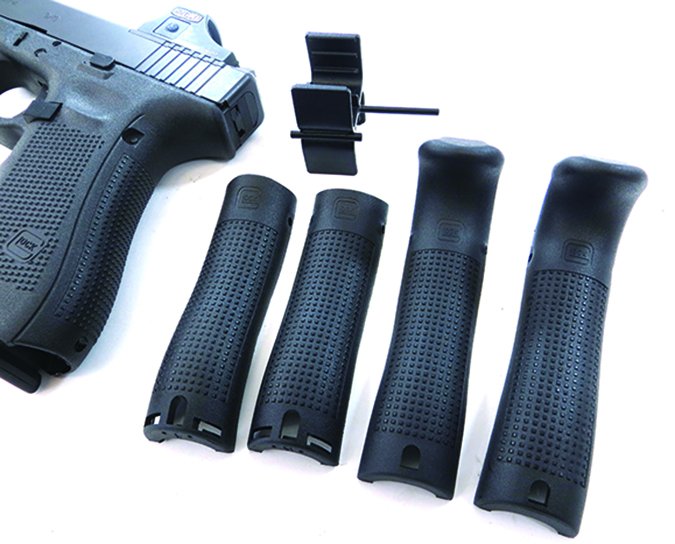
The Gen4 series has a Rough Textured Frame (RTF) surface on the frame and the interchangeable back straps to enhance grip. We felt it did that without being too aggressive. Without a grip strap installed on the G17, the frame is a short-trigger-reach frame, or SF for “short frame.” Four additional backstraps were included, two with a beavertail and two without. The backstraps increased the trigger reach distance. We preferred to use the G17 sans backstraps. Also new in Gen4 pistols is a user-configurable ambidextrous magazine-release button. Gen3 magazines will work in Gen4 pistols if set up for a right-handed shooter, but will not work if the magazine release is set up for left-handed shooters.
Gen4 pistols also have an improved recoil-spring assembly with a dual recoil-spring setup designed to reduce felt recoil. We did notice that recoil was less with the Gen4 assembly. Another enhancement has been made to the trigger via a new disconnector. A pronounced dot or dimple is punched into the disconnector. We felt this new connector made the trigger break cleaner and much more predicable. The press still required 5.5 pounds, but we liked how this enhanced trigger broke.
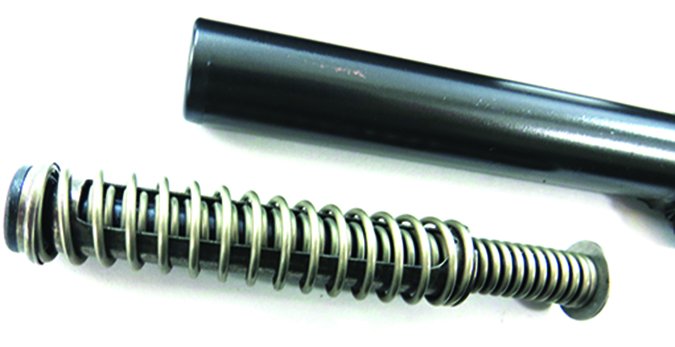
At the range, we found we were more accurate and faster on target compared to iron sights using the Meopta. Accuracy was well under 2 inches at 25 yards using a rest. In fact, with the Winchester Train ammo firing a 147-grain FMJ, our smallest group was 0.8 inches, and, on average with this ammo, we were able to achieve 0.9-inch groups. This accuracy impressed us, and we feel the Gen4 trigger helped achieve that.
We did need ramp-up time to acquire the dot in the reflex sight for all pistols, since we are more familiar with iron sights, but once we were over that hump, we found that we could shoot faster and more accurately with a reflex sight than iron sights. The transition from iron sights to optic also requires the shooter to aim differently. Test members needed to lower the muzzle of the pistol slightly to acquire the red dot within the sight’s window. Within a few magazines, we were comfortable with the optic.
Our Team Said: The G17 Gen4 MOS performed well and gave users the most reflex sight options. It is a good choice for someone wanting a reflex sight on gun that could perform defense and competition duty, but we feel Glock should have added taller sights to co-witness with the optic.
FN America FNX-45 Tactical FDE 66968 45 ACP, $1349
GUN TESTS GRADE: B+
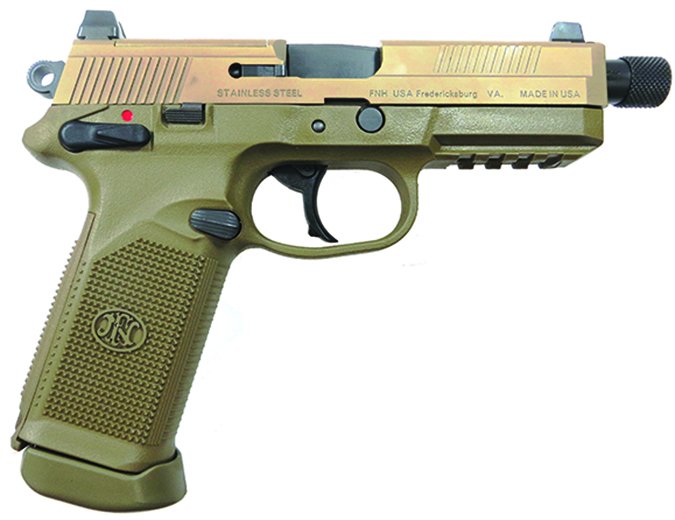
The full size FNX-45 Tactical is best suited for competition or defense applications; optics-mounting options were limited compared to the other two handguns and its cost was much higher.
| ACTION | Semi-auto DA/SA, locked breech |
| OVERALL LENGTH | 8.6 in. |
| OVERALL HEIGHT | 6.7 in. |
| MAX WIDTH | 1.6 in. |
| WEIGHT UNLOADED | 33.3 oz. |
| WEIGHT LOADED | 39.5 oz. |
| BARREL | 5.3 in., 1:16 RH twist; stainless steel; threaded 0.578×28 w/ thread protector |
| CAPACITY | 15+1 |
| SLIDE | Stainless steel FDE; front/rear cocking serrations; top optics cut |
| FRAME | Checkered polymer, FDE 4-slot picatinny rail; replaceable steel frame/slide rails |
| FRAME FRONT STRAP HEIGHT | 2.7 in. |
| FRAME BACK STRAP HEIGHT | 3.2 in. |
| GRIPS | Textured polymer, 4 modular backstraps |
| GRIP THICKNESS (max) | 1.3 in. |
| GRIP CIRCUMFERENCE (max) | 5.7/5.8 in. |
| FRONT SIGHT | High-profile blade, Night Dot |
| REAR SIGHT | High-profile two Night Dots |
| OPTICS MOUNTS | Trijicon RMR, Docter |
| TRIGGER PULL WEIGHT (double) | 13 lbs. |
| TRIGGER PULL WEIGHT (single) | 5.5 lbs. |
| TRIGGER SPAN (double) | 3 in. |
| TRIGGER SPAN (single) | 2.7 in. |
| MAGAZINES | 3; steel double stack |
| SAFETY | Ambi decocking safety lever |
| WARRANTY | Implied lifetime |
| MADE IN | Belgium |
| WEBSITE | FNAmerica.com |
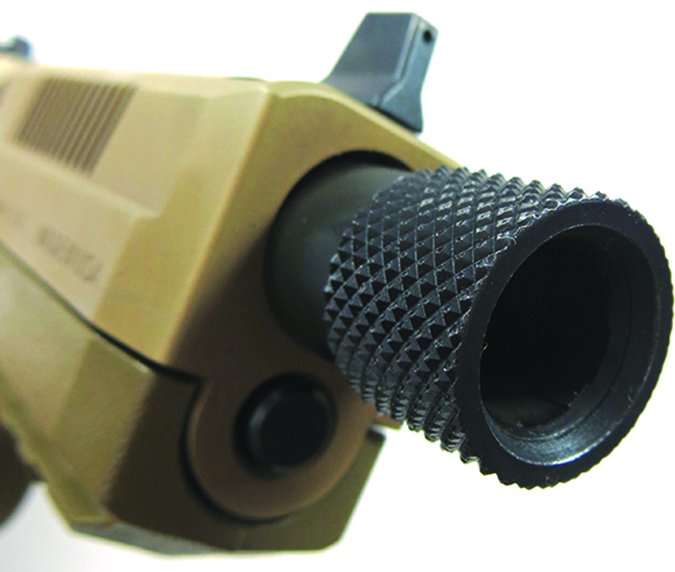
Bud’s Gun Shop listed this at $1183. Hinterland Outfitters listed it for $1149, but it was out of stock. Shooters Plus listed it for $1079 (cash price). The FNX-45 Tactical is a variant of FN’s FNX-45 45 ACP pistol, which we tested in 2009 and graded an A-. The FNX-45 Tactical offers a 5.3-inch threaded barrel, with a knurled sleeve that protects the threads, and an optics-ready slide. The pistol comes in a nylon carry case with pouches, three magazines, four backstrap inserts, and two adapter plates, screws and wrenches.
Like the other pistols, two screws hold a top plate in place, and it is removed and replaced with an adapter plate and reflex sight. Only two adapter plates, one for a Trijicon RMR and one for a Docter USA red dot, were provided. We felt that for such an expensive pistol, more mounting plates should be included. We did not have a Trijicon or a Docter sight available, but we were able to mount a Burris FastFire III using one of the plates and screws provided.
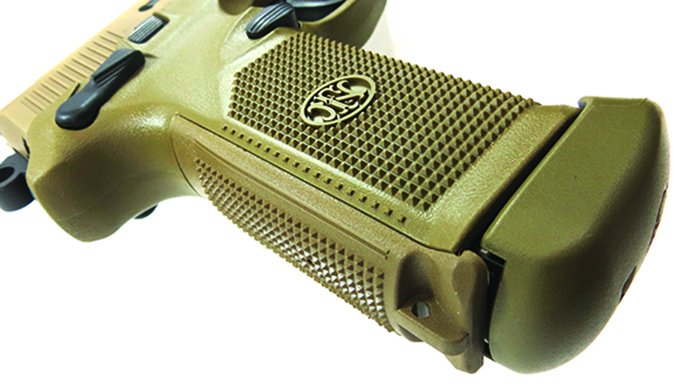
Installation was simple. First, place the plate on the slide, then use two screws to mount the optic. The FN and S&W used two screws total, while the Glock used four screws. The iron sights of the FN were tall and co-witnessed with the red dot. They were also 3-dot night sights, and the shooter-facing side was serrated to reduce glare. We liked these sights the best in this test, with the M&P9 sights coming in a close second. The cocking serrations were placed in good locations forward and rearward, so racking the slide was easy. Neither the G17 nor the M&P9 had forward cocking serrations on the slide. The FN used a flat coil spring and solid guide rod in its front end.
The grip angle of the FNX-45 Tactical is similar to a 1911, which makes it a natural pointer. Like the other pistols, the FN’s polymer frame offered four different backstraps: arched or flat and either checkered or ribbed. We needed a small hex wrench or a paper clip to remove and replace the inserts. The inserts made the pistol feel like it had less girth, which we thought was impressive because the FN holds 15 cartridges in a double-stack magazine. Many testers felt the grip had a girth slightly larger than the two 9mm pistols. The grip sides were checkered and offered good texture without abrasion. The trigger guard was undercut so users can grasp the pistol high.
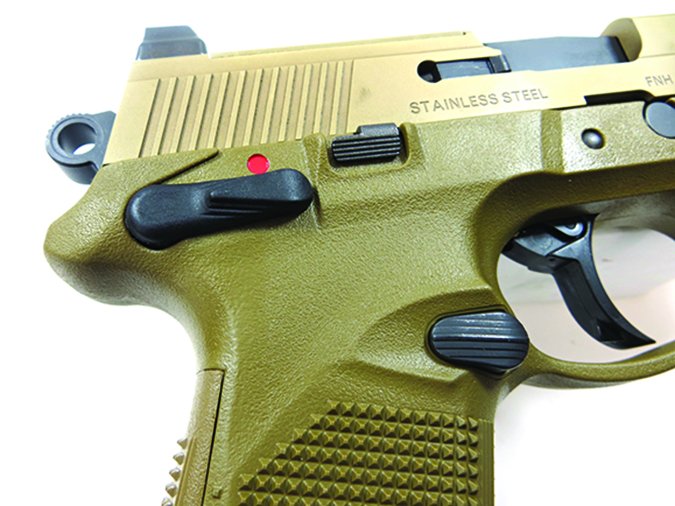
The slide rides on steel rails within the frame, like with all the other pistols, but they were replaceable on the FN. What also set the FN apart from the Glock and S&W was not only the caliber, but the trigger system. The FNX-45 Tactical uses a traditional DA/SA trigger with a double-action press that was smooth and consistent, measuring on average about 13 pounds, though testers felt it was less. In single-action mode, the press averaged slightly over 5 pounds. The trigger was wide, so pulling force was spread across a larger surface area of the finger. The trigger reset was short. We liked this old-school style trigger a lot.
The hammer was round and serrated and allowed easy cocking. Elsewhere, the magazine-release button, decocking lever, and slide stop were ambidextrous, another valuable feature. The magazine release worked precisely. The thumb of the shooting hand naturally falls on top of the decocker, which decocks the hammer from SA mode and places the pistol “on safe” when in DA mode. It functions like a 1911 thumb safety; up position is “on safe,” the down position is “off safe.” In the “off safe” position, a red warning dot was exposed. The slide-stop lever was inset into the polymer frame to avoid moving it inadvertently.
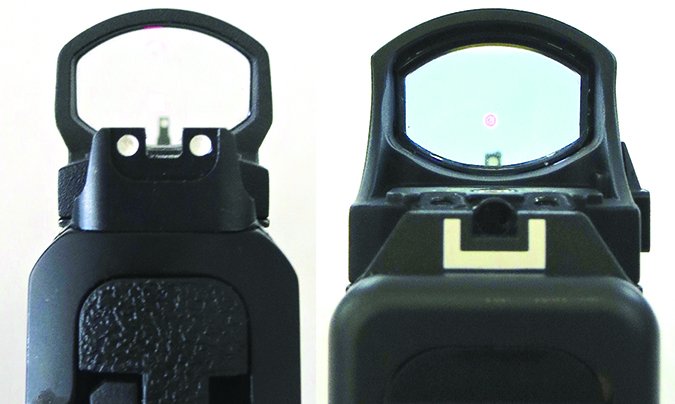
Steel double-stack magazines fed the FN, and they were fairly easy on the shooter’s thumbs when reloading, even when loading the fifteenth round. The floor plate on the FNX’s magazines was large and rounded, so slapping home a fresh magazine into the magazine well was easily accomplished with or without gloves.
All testers agreed the FN was soft shooting. It did not feel like a 45 ACP in recoil. That soft recoil and short trigger reset along with the Burris FastFire II allowed us to shoot the FN fast, but not faster than the 9mms, with good accuracy. We fired 230-grain FMJs from Federal American Eagle and Winchester W Train and hot HPR 185-grain JHPs, and the FN, like the Glock and S&W, ran flawlessly.
Our Team Said: The FNX-45 Tactical offers a lot of features and gave good performance in a soft shooting pistol, but it fell short on optics-mounting options, which was the focus of this test. Naturally, if you want a 45 ACP, it would be the pick above the others.
| 9MM Luger Range Data | ||
| Winchester Train 9mm 147-gr. FMJ | S&W M&P9 Performance Center Ported | Glock G17 Gen4 MOS |
| Average velocity | 984 fps | 982 fps |
| Muzzle energy | 374 ft.-lbs. | 315 ft.-lbs. |
| Smallest group | 0.9 in. | 0.8 in. |
| Average group | 1 in. | 0.9 in. |
| Winchester Defend 9mm 147-gr. FMJ | ||
| Average velocity | 973 fps | 936 fps |
| Muzzle energy | 366 ft.-lbs. | 286 ft.-lbs. |
| Smallest group | 1 in. | 1 in. |
| Average group | 1.5 in. | 1.2 in. |
| Hornady American Gunner 9mm 115-gr. XTP | ||
| Average velocity | 1120 fps | 1118 fps |
| Muzzle energy | 320 ft.-lbs. | 319 ft.-lbs. |
| Smallest group | 0.8 in. | 1.3 in. |
| Average group | 0.9 in. | 1.5 in. |
| Hornady Critical Defense 9mm 135-gr. FlexLock | ||
| Average velocity | 1138 fps | 1010 fps |
| Muzzle energy | 388 ft.-lbs. | 306 ft.-lbs. |
| Smallest group | 1.5 in. | 1.4 in. |
| Average group | 1.8 in. | 1.7 in. |
| 45 ACP Range Data | |||
| FN-USA FNX-45 Tactical | Federal American Eagle 45 ACP 230-gr. FMJ | Winchester Train 45 ACP 230-gr. FMJ | HPR 45 ACP 185-gr. JHP |
| Average velocity | 810 fps | 793 fps | 1004 fps |
| Muzzle energy | 335 ft.-lbs. | 321 ft.-lbs. | 414 ft.-lbs. |
| Smallest group | 2.1 in. | 1.8 in. | 2 in. |
| Average group | 2.6 in. | 2.3 in. | 2.2 in. |
To collect accuracy data, we fired five-shot groups from a bench using a rest. Distance: 25 yards. We recorded velocities using a ProChrono digital chronograph with the first screen set 15 feet from the muzzle.
Written and photographed by Robert Sadowski, using evaluations from Gun Tests team testers.





























